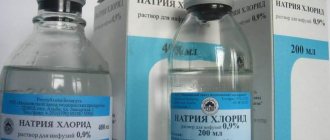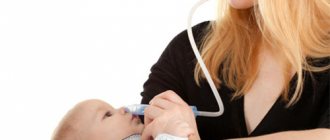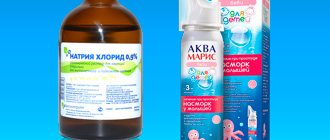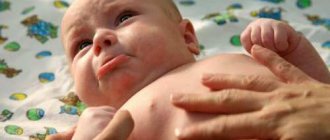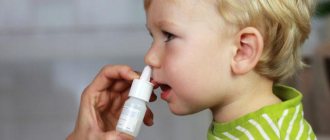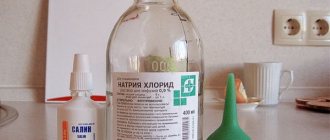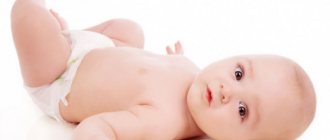Quite often, parents notice that newborn babies breathe heavily through their nose. This is explained by the fact that in children of the first year of life, the nasal passages are very narrow and even the slightest accumulation of mucus leads to difficulty breathing. Since babies do not yet know how to blow their nose, parents should know how to properly clean the nasal passages so as not to injure them. If a child’s nose is not promptly cleared of mucus and crusts, he begins to eat poorly and does not gain weight. In addition, children with a clogged nose are very irritable and whiny.
What to prepare to cleanse your nose
A pediatrician or visiting nurse will tell you how to properly clean a newborn’s nose from snot at home. This procedure is not difficult to carry out, and parents will quickly understand how to do everything. The main thing here is not to rush, all movements must be careful, since the baby’s mucous membrane is delicate and easily injured. Before you start cleaning your baby's nose, you should prepare all the necessary supplies. For the hygiene procedure you will need:
sterile cotton wool;- vegetable oil - peach, flaxseed, vaseline or regular refined oil, which was previously boiled in a water bath;
- a soft napkin made of clean rags or gauze;
- a small syringe with a rubber tip;
- special aspirator.
In addition, you should prepare a small soft towel, which is placed under the baby’s head, pipette and saline solution . Instead of saline solution, you can simply take a salt solution prepared from a tablespoon of table salt and a liter of boiled water.
To rinse the nose of newborn babies, you can use a solution of sea salt. It is diluted in the following ratio: half a teaspoon per glass of water.
How to clean snot from a newborn baby's nose
If there is only a small amount of snot, it will be enough for the infant to put some drops in his nose and clean it with a flagellum.
To do this you will need:
- Sterile cotton wool, preferably discs;
- Peach or apricot oil, or just boiled sunflower oil;
- Saline solution or salted boiled water, or a special solution;
- Napkin.
Next, perform the following procedure in each necessary case:
- Drop the solution into each nostril one at a time;
- Take sterile cotton wool or, better yet, disks, where the structure is denser, tear off a small piece and twist the lace with moistened fingers;
- You cannot use sticks, they injure the mucous membrane;
- You should not clean your baby’s nose with dry cotton wool, it causes discomfort;
- Next, insert a flagellum soaked in oil into the already dripped nose no more than 2 cm and scroll to collect all the softened crusts;
- Then repeat the procedure;
- If the spout gets dirty with mucus and oil, blot it with a napkin.
Remember that the air in the room where the baby lives should be moist and cool; this is a favorable environment for healthy mucous membranes, which can clean themselves through special hairs and natural sneezing.
But if a newborn has a lot of mucus, then cleaning alone is not enough; it is necessary to resort to more effective methods.
Do you know the best cure for chickenpox for children? Here you will learn the most effective medications to combat chickenpox. It will also be useful for you to know what body temperature a newborn baby should have, since maintaining a normal temperature is very important for the baby’s condition.
And if you want to know how Monastic antiparasitic tea works, just follow the link https://helsbaby.ru/monastyrskijj-antiparazitarnyjj-chajj-pravda-ili-razvod.html and you will find out how Monastic tea fights parasites.
How to clean your nose with an aspirator
Clearing snot from an infant's nose is sometimes very problematic, since small children do not like this procedure and usually turn their heads violently. It is convenient when one adult holds the baby while the second one cleans the nose.
To clean mucus from a baby’s nose under normal home conditions, you must follow these recommendations:
- The baby is placed on a horizontal surface. This could be a changing table, bed or sofa, pre-covered with a diaper. It is very important that the baby’s nose is well lit;
- take an aspirator or rubber bulb, release the air from it by squeezing, then insert it a few millimeters into the nasal passage and release the bulb. When pulling snot from one nostril, the second should be slightly covered with a finger;
- after one nostril is cleared of mucus, the second is cleaned in the same way.
If the mucus in the nose is too thick, it should first be thinned. To do this, saline solution, Aqua Maris or regular salted water are instilled into the nasal passages. No more than 1 pipette of this solution should be dripped into each nasal passage. After this, wait a couple of minutes and only then clean your nose.
After all the mucus from the nasal passages has been drawn out with an aspirator, you should dry the baby’s nostrils with cotton wool. In this case, each nasal passage takes its own cotton wool.
You should not drip regular water onto your child’s nose. The solution must be slightly salty.
How does the cleansing process begin?
When everything is ready and done, you need to start. Every parent should be prepared for the fact that this procedure is not easy and it will not be possible to do everything simply. The baby can give any reaction, including a negative one, so you shouldn’t assume that everything will be easy. Oddly enough, the child does not like many hygiene procedures, but if they are done as often as they should be, the baby gradually gets used to it.
If there are not only crusts in the nose, but also liquid snot, then the nose is initially washed with the same prepared solutions. What happens next:
- Once the crusts in the nose have softened, this takes a matter of minutes. After which you need to begin inserting the flagella into the nose, but with smooth twisting movements in a clockwise direction. By twisting it and then gradually pulling it out, everything gets attached to them.
- When the snot does not become a crust, but simply flows, then several times during the day it is also worth rinsing the passages with saline solutions. But there is one peculiarity: you should not do them yourself, because you can burn the mucous membrane of the baby’s nose, this will cause him pain. The best thing for babies is sea water from a pharmacy; it has a drying and antibacterial effect. This type of nose cleaning is the best and most effective.
- Red irritations can often appear when a child or mother wipes away snot, and these need to be dealt with immediately. To do this, before going to bed, simply lubricate it with any fatty baby cream. There are also special products from the pharmacy that help remove irritations on the skin of a newborn of any complexity.
These are the most affordable ways to deal with nasal problems in a baby. There is no need to invent anything and use folk recipes, because the body’s reaction can be anything, and the fight against one problem can lead to other disorders. It is better to understand in the first stages why snot is formed, since it could also be an allergy to something. When the irritant goes away, the problem will resolve itself. Attentive attitude on the part of parents is what should happen to a child from the moment he is born.
How to deal with snot using a rubber bulb or nasal aspirator?
In the pharmacy you can find special aspirators or bulbs; with their help, it is easier to remove any accumulation in the baby’s nasal passages. It turns out that this is the answer to the question of how else you can remove unnecessary crusts. The algorithm of operation of such a device is unique. In order not to violate anything, it is better to first read the instructions in detail and perform each step as expected.
Nasal aspirator - the rinsing process occurs due to vacuum. All secretions from the baby's nasal passage are collected. But how does a rubber bulb work? There is no difficulty in this, because everyone has seen a syringe, so such devices are practically no different from it in terms of the technique of performing the procedure. The only difference is the tip, it is made of soft silicone so as not to cause harm. You need to approach this process wisely and do everything step by step:
- The first thing is to press the bulb itself, the air comes out.
- After which the silicone tube is placed into the child’s nasal passage, but a few millimeters, you should not go deeper. And the second nostril is closed with a finger.
- After which the pear unclenches and the process of drawing in everything unnecessary and liquid begins.
- After which the procedure is performed in the second nostril.
- After this, you need to take a flagellum from the cotton wool and remove all the remains.
This is a simple procedure and every mom and dad can do it. But you should not ignore the presence of snot in a baby if there are no additional signs. Often children refuse to eat in such infancy and the mother does not understand why this happens. But after the doctors’ visit, it becomes clear that the child’s nasal hygiene is not being maintained.
But these are not all ways to help parents. There is also a silicone tube that also cleans the nasal passages. But how to wash her nose? The process of action is elementary - carefully one end is inserted shallowly into the child’s nostril, the other mother takes the insert and begins to suck in the contents. You need to do this carefully, because the baby may twitch and the tube may deepen. It’s better together, one parent holds the child, and the other removes unnecessary things from the nose. Also, after the process, a flagellum is additionally applied to completely remove all residues.
As soon as a baby appears in the house, you need to decide which method is most suitable for getting rid of mucus from the nasal passages. Children can also become infected with colds in infancy; in such a situation, it is simply impossible to do without rinsing. Because the baby does not yet know how to blow his nose. To avoid tears and frustration, you will have to learn one method and apply it. It also happens that children under two years of age cannot learn how to blow their nose, so you can purchase a special device from a pharmacy, since it will be needed for a long period of time.
But parents should show how to blow their nose, inhale and exhale air from the nose. Gradually the child will be able to do this himself. You should never use drops at an early age, because an adult’s body quickly gets used to them, and even more so an immature child’s body. It is better to purchase a rinse or use a simple saline solution and do it with a spray bottle.
All parents should not listen to the advice around them, because some actions help one child, but do not benefit another or may even harm them. If you have a runny nose, then some wrong actions can prolong everything and lead to serious complications. No amateur performances or traditional medicine.
If it is difficult for mom to understand how all this is done, then you need to consult a doctor, let him show during the visit that this is not difficult. When the child is not sick, the procedure of cleansing his nose should be carried out daily, just like taking a bath. In this way, the mother not only makes his breathing full, but also moistens the mucous membrane, which improves its protective functions. This will allow the baby to stay healthy and protect his body from germs around him.
Experienced parents make this process easy and simple. You should not show your fear, as the child feels all this strongly, especially from the mother, since there is a strong connection. When she is nervous and doubts the correctness of her actions, the same thing happens to the child. You will have to prepare not only everything you need, but also mentally get into the right frame of mind. After cleaning your baby's nose for the first time, everything will be done without any problems.
How to clean your nose with a cotton swab
You can also clean a baby's nose from viscous snot using a cotton swab.
To do this, twist two turundas from sterile cotton wool and moisten them in boiled vegetable oil or vaseline oil. Clean the nostrils one by one, using a different flagellum for each. Oil softens crusts and mucus so they can be easily removed. Then take dry cotton wool and clean the nostrils with them one by one until they become completely dry. One procedure can take up to 10 cotton wool flagella.
It is strictly forbidden to clean a small child’s nose with cotton swabs. In this case, there is a high probability of injury to the delicate mucous membrane.
Cleaning a baby's nose with a pear
The syringe should be purchased in a small size and with a soft tip. Before use, you need to rinse it thoroughly. During the procedure, the child must be in an upright position. You need to pinch one of the baby’s nostrils with your finger, press it to remove all the air from the bulb, insert its tip into the open nostril and slowly release your palm from the squeezing syringe. The contents of the nasal passages will be drawn into the syringe along with the air. Wash the pear thoroughly after use.
You cannot clean a baby’s nose of snot while dry; before the procedure, you need to drip human milk, 0.9% sodium chloride solution or drops based on sea water (Aquamaris, Aqualor baby, Otrivin baby). This will soften the crusts, and cleaning the nose will not be painful.
If the sniffles bother your baby too often, then just cleaning the nose will not help - you need to fight the infection (cold). We wrote about how to treat snot in children under 1 year of age in the article [treatment of snot in infants].
Cleaning the nose with a tube aspirator
At home, you can also clean your baby’s nose using an aspirator, which is made in the form of a silicone tube with a small container closer to one end. Such aspirators have recently gained particular popularity, as mothers noted that they are very convenient to use. The procedure for cleaning the nose looks like this:
- The baby is placed on his back, on a solid surface. If necessary, one of the adults can hold the baby in their arms;
- One end of the aspirator is inserted into the child’s nostril, and the second end is inserted into the child’s mouth by the mother or one of the adults. Then the adult begins to suck in air;
- after one nostril is cleared of mucus, carry out the same procedure with the second nasal passage.
The convenience of using such an aspirator is that you can easily adjust the force of air intake. Due to this, the snot is quickly removed and ends up in a special container, which then just needs to be washed.
After use, the aspirator is washed well with running water, dried, and only then stored.
General requirements for the procedure
To begin with, it is worth ventilating and, if necessary, humidifying the air in the room in which the child sleeps (plays, rests), the room should always be clean. The optimal air temperature is 20 degrees, humidity levels should be close to 60%.
To rinse your baby’s nose correctly, you should first prepare a saline solution (an alternative is salted water, 1 teaspoon of salt/1 liter of liquid), cotton wool, petroleum jelly, a pharmaceutical aspirator (can be replaced with a soft syringe with a tip of minimal diameter), as well as a soap solution for cleaning instruments.
Before cleaning your newborn's nose, you must thoroughly wash and disinfect your hands. It is advisable to carry out the procedure itself on a changing table or any other hard surface.
A regular pipette will also help remove excess mucus from your baby’s nasal passages.
The first step is to drip 1-2 drops of saline solution into each nostril (to remove boogers and soften crusts). Pharmacies also sell special drops, sprays, and aerosols, which pediatricians recommend to clear the nose of infants. The list of the most popular products of this kind includes: Marimer, Aqualor, Aquamaris, No-sol, Humer, Dolphin.
Important! Despite the fact that such local preparations have a safe hypoallergenic composition, they should be used with caution. Before injecting the solution, the child should be picked up - the liquid should not get into the internal nasal passages, this is fraught with the development of otitis (an inflammatory process in the ear).
After this, you need to independently make thin cotton wool flagella no more than 7 cm long, soak them in Vaseline oil, insert them into each nasal passage, rotating them slightly. At the end of the manipulations, slowly and carefully pull out the cotton wool. At the end of the procedure, the baby's nose is wiped with a clean cotton swab.
Important! The described steps can be repeated several times in a row (until the child’s nose can be completely cleared of mucus and other contaminants).
A rubber bulb is another convenient device for clearing the nose of infants. Pharmacies offer a wide selection of mechanical, electronic, and vacuum pediatric nasal aspirators. If there is quite a lot of discharge in the nose, it is advisable to cleanse it with an aspirator or an ordinary small bulb.
Nasal rinse bulb
Using an enema for home procedures related to cleaning a child’s nose is easy:
- It is necessary to thoroughly rinse the soft tip and release the air from the bulb;
- close one nostril of the baby with your finger and insert the tip of the device into the other;
- After the enema is released, the discharge from the child’s nose will be drawn into its body.
Upon completion of the manipulations, the bulb and tip are thoroughly washed with soap, and the described actions are repeated from the second nostril. In fact, you should also clean the nose of a month-old baby with a pharmaceutical aspirator. This design consists of replaceable filters and flexible tubes, one of which is inserted into the baby’s nostril, through which secretions are removed from the nose into a special container.
Homemade cotton swabs for cleaning the nose
Not only mechanical, but also electronic, as well as vacuum aspirators are widely represented in modern pharmacies. They are convenient to use for those parents whose child does not allow them to clean their nose using the methods described above. Such devices are not cheap, but at the same time they allow you to quickly and safely remove snot from the baby’s nose thanks to the negative pressure in the system.
Cleaning the nose with a cotton pad
It is easier to clear your nose with flagella made from cotton pads than with just cotton wool turundas. This is explained by the fact that cotton pads are made of pressed cotton wool, which does not spread.
To make a flagellum, take a disk and cut it in half with scissors. One half is set aside, and the second is cut into 4 more pieces. Next, take one part of the cotton pad, twist it a little with your fingers and use it to clean your nose. When clearing mucus, you need to make careful rotational movements with the flagellum. It is unacceptable to vigorously clean your nose, as you can damage the mucous membrane.
How can you clean your baby's nose?
Cleansing manipulations of the respiratory tract are an unpleasant hygienic procedure for infants. He will turn his head and cry, and therefore you need to be extremely careful. Modern pediatricians, such as Dr. Komarovsky, do not recommend doing the following:
- Use your mouth to suck mucus out of your newborn's nose.
- Drip breast milk into the baby's nostrils, which can immediately develop microbes.
- Do not use cotton swabs or matches with cotton wool wrapped around them for cleaning; these devices can injure the baby’s nasal mucosa.
Before you start cleaning your newborn's nose, you need to prepare all the necessary items in advance. The choice of such devices for cleaning the respiratory tract depends on the degree of blockage of the nose, the age of the child, and the reason for the procedure (congestion, daily care). Let's look at the most common spout cleaning tools, their types and methods of use.
- How can a pensioner protect himself from apartment fraud?
- How is northern experience taken into account when assigning a pension - calculation rules
- Diapers for newborns
Aspirator
A special hygienic device for suctioning mucus in newborns, which does not cause discomfort, is called an aspirator. Before using this device, the spout is slightly moistened with a special solution. There are several types of aspirators:
- Mechanical. It is a small transparent container for snot with a straw and removable nozzles. One end of the tube is inserted into the newborn's nostril; through the second, the mother sucks in air and draws mucus from the nose into a special container.
- Electronic. This is a special battery-powered “pear” that, at the press of a button, pulls out snot. An electronic aspirator often has additional functions - humidification, aerosol.
- Vacuum. This device is used very rarely at home. In appearance, it resembles a mechanical aspirator, but it works by connecting to a special vacuum cleaner. It's inconvenient, noisy, cumbersome.
Aquamaris
To moisturize the mucous membrane of a newborn's nose and soften the crusts, use Aquamaris natural sea water. This drug can be used by infants under one year of age only in the form of drops; the spray is used for children over 1 year of age. Aquamaris drops contain many microelements and active substances, thanks to which the drug perfectly removes dust, takes care of the normal functioning of the nasal mucosa, and increases local immunity.
Syringe
The easiest to use and most common aspirator is a syringe. In appearance, it resembles a regular “pear”, but has a special removable silicone tip. For newborns, small syringes with soft silicone nozzles are used. The principle of operation of the device is simple - you squeeze the syringe with your hand so that the air comes out of it, and then you need to insert the tip into the baby’s nostril, gently open the bulb and pump out the mucus.
- Schizophrenia - symptoms and signs
- How to fold a T-shirt
- Topiary made of satin ribbons
Pear
This is a traditional device that our mothers and grandmothers used. It was made of dense rubber and had a thin and soft tip. Using such a device is inconvenient and traumatic for a newborn. Modern pears have been improved:
- they have a wide tip that does not go too deep into the nostril;
- The tip of the device is removable, it can be easily unscrewed and washed;
- The material of the bulb is silicone, which is much stronger than rubber and leads to less mucus suction force.
Cotton flagella
To remove small amounts of snot, crusts, and for daily hygiene procedures with a newborn, cotton pads are used. To make such a flagellum, you need to twist it from a piece of long cotton wool. Next, the device is lightly moistened with a special solution or sterile Vaseline and inserted into one nostril of the baby with slow rotational movements to a depth of 2 cm, then slowly and carefully removed. The procedure is repeated for the other nostril, but a new flagellum is used.
How to relieve nasal congestion
In young children, nasal congestion can occur when regularly inhaling too dry or warm air.
To reduce the formation of mucus and crusts, as well as eliminate nasal congestion, it is necessary to maintain optimal temperature and humidity in your home. The children's room must have a thermometer and hygrometer. The air temperature should be kept no higher than 21 degrees, and humidity about 60%. If the air in your home is too dry, you can install a household humidifier. In addition, you can increase the humidity by hanging towels around the room or installing an aquarium. It is worth considering that you can place an aquarium in a child’s room only if the child is not predisposed to allergies.
What to pay attention to
Parents should be very careful when cleaning their baby's nose. It should be borne in mind that the baby’s mucous membrane is very vulnerable, so you cannot apply much effort. In addition, the following recommendations should be followed:
- You should not start cleaning your child’s nose if he is very excited and crying;
- It is advisable to carry out hygiene procedures at a time when the child is in a good mood. It is better to do this half an hour after eating;
- Do not drop any oily solutions or plain water into the nose of a newborn baby;
- It is unacceptable to rinse the nose of a newborn. No more than 2 ml of liquid can be poured into each nostril, and then with the child lying on his side.
Cleaning a newborn baby's nose is not difficult if you know the basic recommendations. This procedure should be carried out in a well-lit place, without haste. To clean the nasal passages, an aspirator or rubber bulb is used, after which the nose is wiped dry with cotton wool. We must not forget that a separate flagellum should be used for each nostril.
